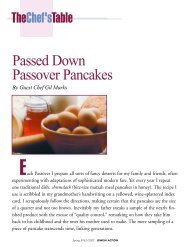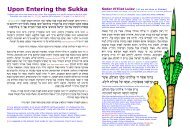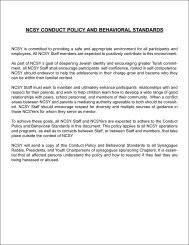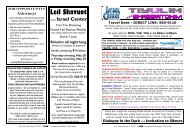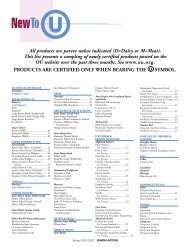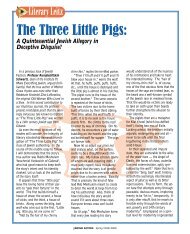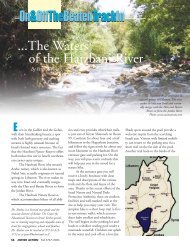Create successful ePaper yourself
Turn your PDF publications into a flip-book with our unique Google optimized e-Paper software.
into a pool within the city walls and thereby denying it to the<br />
invader. In 1880, an extraordinary inscription carved in<br />
beautiful paleoHebrew was discovered on the tunnel wall 6m<br />
from the pool. This inscription (now in an Istanbul museum)<br />
dramatically describes the final moments of the completion of<br />
the excavation when the two teams of tunnelers working from<br />
opposite ends met. "And this was the manner of the boring<br />
through: when yet the hewers were lifting the pickaxes, each<br />
towards his fellow, and when there were 3 Amot yet to be<br />
bored (through the rock), the voice of each calling to his fellow<br />
was heard … .And at the end of the boring, the hewers<br />
struck,each to meet his fellow, pickaxe against pickaxe. Then<br />
the waters went from the source to the pool (in the city) for 200<br />
and 1000 Amot. 100 Amot was the height of the rock above the<br />
heads of the hewers… ". Melachim Bet 20:20 summarizes the<br />
achievements of Hezekiah's reign, "And the rest of the acts of<br />
Hezekiah… how he made the pool, and the conduit, and<br />
brought water into the city, are they not written in the books of<br />
the chronicles of the kings of Judah?"<br />
Various Midrashim relate that, with the destruction of<br />
Jerusalem, Malchut Beit David, the honor of the Kohein Gadol,<br />
Ru'ach Hakodesh, the Sanhedrin, the Beit HaMikdash and the<br />
abundance of the waters of the Gichon passed away. The<br />
Midrash relates how after the Destruction, Gd reduced the<br />
Gichon, which had previously fructified all of Eretz Yisrael, to<br />
a comparatively insignificant fountain. We are also told that the<br />
Gichon played a vital role in the dawn of human history. Pirkei<br />
Rabbi Eliezer teaches us that "… after his expulsion from Gan<br />
Eden, Adam HaRishon betook himself to the waters of the<br />
upper Gichon where, without food, he stood up to his neck in<br />
the water for seven weeks continually until his body became<br />
perforated like a sponge. He then prayed to Gd saying:<br />
'Forgive my sins and accept my repentance, so that all future<br />
generations may know that repentance is efficacious and that<br />
You will forgive those who return to you.' Whereupon Gd<br />
stretched forth His right hand, accepted Adam's repentance and<br />
forgave his sins." (The Midrash notes the similarity of Gichon<br />
to Gachan he bent down, i.e. he repented.) Is the theme of<br />
repentance the true link between the waters of the Gichon, its<br />
adjoining pool the Shilo'ach, and the Nisuch Hamayim? Would<br />
this not be a connection of far greater import than mere<br />
geographical proximity? Can we picture the Kohanim as they<br />
performed Nisuch HaMayim whispering in prayer, "As Adam<br />
HaRishon's sin was forgiven as a result of his penitence when<br />
he stood in the Gichon, so may the transgressions of Am<br />
Yisrael his descendent be forgiven as we pour water from that<br />
very same spring on the Mizbei'ach"? Did not Rabbi Akiva<br />
visualize Gd saying, "Pour out water before Me on Sukkot, so<br />
your rains this year will be blessed"? (Rosh HaShana 16a)<br />
"My transgressions do I recall this day..." I have been living in<br />
Jerusalem for almost 35 years and I never "did" Hezekiah's<br />
Tunnel, something almost every tourist does. I finally did it<br />
only a couple of weeks ago. Armed with flashlights and<br />
expendable sneakers, together with a small group I visited the<br />
growing Jewish community of Ir David and then entered<br />
Hezekiah's conduit, water up to my knees. I found it very<br />
meaningful to see the very place where MY king, King<br />
Solomon, was anointed and to have the privilege of climbing<br />
through the engineering marvel dug by his resourceful<br />
descendent, Hezekiah King of Judah. Gazing upon the<br />
Shilo'ach, it was not hard for me to "see" thousands of<br />
whiteclad Kohanim joined by an immense jubilant crowd<br />
congregating near the water. To the sound of trumpets, a<br />
Kohein approached the Shilo'ach pool, the waters of Gichon<br />
where Adam HaRishon obtained forgiveness for his<br />
transgression. The Kohein held a golden flagon in his hand...<br />
Catriel is in the process of writing a book: The Temple of Jerusalem,<br />
A Pilgrims Prospective; A Guided Tour through the Temple and the<br />
Divine Service<br />
Parsha Pix<br />
Busy, busy sedra. Upper left: Soldier in a tank, represents the<br />
many times "military" issues are mentioned in the sedra The<br />
Beautiful Captive, the cleanliness of an army camp, exemption<br />
from service for a groom for the first year of marriage...<br />
The warning lights are to prevent someone getting injured from<br />
a hazard in one's property. This is the flip side of the mitzva of<br />
MAAKEH.<br />
The boot represents CHALITZA and the whole subject of<br />
YIBUM.<br />
The nest with the eggs is the scene immediately after someone<br />
has fulfilled the mitzva to send away the mother bird.<br />
The couple under the CHUPA stands for several topics related<br />
to marriage.<br />
The hands holding the wallet, taking out money is for the<br />
different monetary mitzvot in the sedra not to borrow with<br />
interest. To pay a laborer on time. To fulfill one's pledges...<br />
There is a cluster of grapes on top of a stalk of wheat to<br />
represent K'LAI KEREM.<br />
The toilet is for the requirement of having sanitary facilities<br />
outside an army base.<br />
The string around the finger is for the various mitzvot to<br />
remember what happened to Miriam, being in Mitzrayim,<br />
Amalek.<br />
The gravemarker is for the mitzva to bury our dead, and<br />
reasonable quickly.<br />
The donkey is for the many references to either donkey or other<br />
animal. The donkey gets lost, he is overburdening, he cannot<br />
pull a plow together with an ox...<br />
The barbells with different weights on each end represents false<br />
weights and measures. Forbidden to use to defraud someone,<br />
and even forbidden to possess.<br />
The aardvark and giraffe are tied together. That is a Torah<br />
violation, even according to Rambam who says that for the<br />
Torah law to be violated, one animal has to be kosher and the<br />
other not.<br />
There is a time clock representing paying the worker on time,<br />
and also the mitzvot related to workers' rights and employers'<br />
rights, as well.<br />
There's a Purim grogger in the lower right corner. Stands for<br />
ZACHOR and especially wiping out Amalek. This is the origin<br />
of making noise when Haman's name is read.<br />
KEY = KI, the word that starts the sedra off and appears 48<br />
times in the sedra. That's a lot.<br />
The apple tree can be for the rules of SHICH'CHA or the<br />
location of a nest, or for the rules to allow apple pickers to eat<br />
during their breaks.<br />
That leaves three unexplained items, which are to be added to<br />
the regular TTriddles.<br />
NOTICE: The OU Israel Center and Torah Tidbits do not necessarily<br />
endorse the political, medical, or halachic positions of its advertisers,<br />
nor do we guarantee the quality of their service or product.<br />
Israel Center TT #633 (.pdf version) · page 11 · Shabbat Parshat KI TEITZEI



